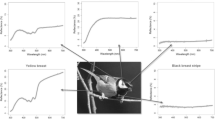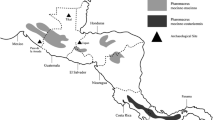Abstract
Resource subsidies are well known to increase population densities of consumers. The decomposition process of these subsidised resources can be influenced by increasing consumer abundance. However, few studies have assessed whether resource subsidies can promote resource decomposition via a population increase in consumers. Here, we examined the effects of keratin subsidies on feather decomposition in egret and heron breeding colonies. Egrets and herons (Ardeidae) frequently breed in inland forests and provide large amounts of keratin materials to the forest floor in the form of feathers of chicks (that die). We compared the decrease in the weights of egret and heron feathers (experimentally placed on the forest floor) over a 12-month period among egret/heron breeding colonies (five sites) and areas outside of colonies (five sites) in central Japan. Of the feathers placed experimentally on forest floors, 92–97 % and 99–100 % in colonies and 47–50 % and 71–90 % in non-colony areas were decomposed after 4 and 12 months, respectively. Then, decomposition rates of feathers were faster in colonies than in areas outside of colonies, suggesting that keratin subsidies can promote feather decomposition in colonies. Field observations and laboratory experiments indicated that keratin-feeding arthropods and keratinophilic fungi played important roles in feather decomposition. Therefore, scavenging arthropods and keratinophilic fungi, which dramatically increased in egret and heron breeding colonies, could accelerate the decomposition of feathers supplied to the forest floor of colonies.





Similar content being viewed by others
References
Aoki J (ed) (1999) Pictorial keys to soil animals of Japan. Tokai University Press, Tokyo, Japan (In Japanese)
Bates D, Maechler M, Bolker B (2011) lme4: linear mixed-effects models using S4 classes. R package version 0.999375-42
Benfield EF, Webster JR (1985) Shredder abundance and leaf breakdown in an Appalachian Mountain stream. Freshw Biol 15:113–120. doi:10.1111/j.1365-2427.1985.tb00701.x
Błyskal B (2009) Fungi utilizing keratinous substrates. Inter Biodeterior Biodegrad 63:631–653. doi:10.1016/j.ibiod.2009.02.006
Carter DO, Yellowless D, Tibbett M (2007) Cadaver decomposition in terrestrial ecosystems. Naturwissenschaften 94:12–24. doi:10.1007/s00114-006-0159-1
Crawley MJ (2005) Statistics, an introduction using R. John Wiley, New York
Davis PG, Briggs DE (1995) Fossilization of feathers. Geology 23:783–786. doi:10.1130/0091-7613(1995)023<0783:FOF>2.3.CO;2
Goldstein G, Flory KR, Browne BA, Majid S, Ichida JM, Burtt EH (2004) Bacterial degradation of black and white feathers. Auk 121:656–659. doi:10.1642/0004-8038(2004)121[0656:BDOBAW]2.0.CO;2
Hughes J, Vogler AP (2006) Gene expression in the gut of keratin feeding clothes moths (Tineola) and keratin beetles (Trox) revealed by subtracted cDNA libraries. Insect Biochem Mol Biol 36:584–592. doi:10.1016/j.ibmb.2006.04.007
Ishiwata S, Hanada S, Hayashi F, Yamasaki T, Uemura Y, Aoki T, Hayashi M, Nozaki T, Fukuda H, Kishida Y, Hayashi N, Shinohara A, Shinonaga S (2005) Insect larvae of Japan. Gakken, Tokyo (in Japanese)
Japanese Ant Database Group (2008) Japanese ant image database. http://ant.edb.miyakyo-u.ac.jp/E/index.html. Accessed 17 December 2014
Kawai S, Hori S, Kawahara M, Inagaki M (2005) Atlas of Japanese Scarabaeoidea, vol 1. Coprophagous group. Roppon-Ashi Entomological Books, Tokyo
Klemmer AJ, Wissinger SA, Greig HS, Ostrofsky ML (2012) Nonlinear effects of consumer density on multiple ecosystem processes. J Anim Ecol 81:770–780. doi:10.1111/j.1365-2656.2012.01966.x
Kolb GS, Jerling L, Hambäck PA (2010) The impact of cormorants on plant-arthropod food webs on their nesting islands. Ecosystems 13:353–366. doi:10.1007/s10021-010-9323-8
Kolb GS, Jerling L, Essenberg C, Palmborg C, Hambäck PA (2012) The impact of nesting cormorants on plant and arthropod diversity. Ecography 35:726–740. doi:10.1111/j.1600-0587.2011.06808.x
Lauber CL, Metcalf JL, Keepers K, Ackermann G, Carter DO, Knight R (2014) Vertebrate decomposition is accelerated by soil microbes. Appl Environ Microbiol 80:4920–4929. doi:10.1128/AEM.00957-14
Lin SJ, Wideliz RB, Yue Z, Li A, Wu X, Jiang TX, Wu P, Chuong CM (2013) Feather regeneration as a model for organogenesis. Develop Growth Differ 55:139–148. doi:10.1111/dgd.12024
Mashiko M, Toquenaga (2013) Increasing variation in population size and species composition ratio in mixed-species heron colonies in Japan. Forktail 29:71–77
McIntosh AR, Greig HS, Mcmurtrie SA, Nyström PER, Winterbourn MJ (2005) Top-down and bottom-up influences on populations of a stream detritivore. Freshw Biol 50:1206–1218. doi:10.1111/j.1365-2427.2005.01394.x
Mondor EB, Tremblay MN, Tomberlin JK, Benbow EM, Tarone AM, Crippen TL (2012) The ecology of carrion decomposition. Nat Educ Knowl 3:21
Parmenter RR, MacMahon JA (2009) Carrion decomposition and nutrient cycling in a semiarid shrub-steppe ecosystem. Ecol Monogr 79:637–661. doi:10.1890/08-0972.1
Pechal JL, Benbow ME, Crippen TL, Tarone AM, Tomberlin JK (2014) Delayed insect access alters carrion decomposition and necrophagous insect community assembly. Ecosphere 5:45. doi:10.1890/ES14-00022.1
Polis GA, Hurd SD (1996) Linking marine and terrestrial food webs: allochthonous input from the ocean supports high secondary productivity on small islands and coastal land communities. Am Nat 147:396–423. doi:10.1086/285858
Polis GA, Anderson WB, Holt RD (1997) Toward an integration of landscape and food web ecology: the dynamics of spatially subsidized food webs. Annu Rev Ecol Syst 28:289–316. doi:10.1146/annurev.ecolsys.28.1.289
Pugh GJF, Evans MD (1970a) Keratinophilic fungi associated with birds. I. Fungi isolated from feathers, nests and soils. Trans Br Mycol Soc 54:233–240. doi:10.1016/S0007-1536(70)80036-5
Pugh GJF, Evans MD (1970b) Keratinophilic fungi associated with birds. II. Physiological studies. Trans Br Mycol Soc 54:241–250. doi:10.1016/S0007-1536(70)80037-7
R Development Core Team (2012) R, a language and environment for statistical computing. R Foundation for Statistical Computing, Vienna
Rushton SP, Hassall M (1983) Food and feeding rates of the terrestrial isopod Armadillidium vulgare (Latreille). Oecologia 57:415–419. doi:10.1007/BF00377189
Sánchez-Piñero F, Polis GA (2000) Bottom-up dynamics of allochthonous input: direct and indirect effects of seabirds of islands. Ecology 81:3117–3132. doi:10.1890/0012-9658(2000)081[3117:BUDOAI]2.0.CO;2
Sharma R, Rajak RC (2003) Keratinophilic fungi: nature’s keratin degrading machines! Resonance 8:28–40. doi:10.1007/BF02837919
Spiller DA, Piovia-Scott J, Wright AN, Yang LH, Takimoto G, Schoener TW, Iwata T (2010) Marine subsidies have multiple effects on coastal food webs. Ecology 91:1424–1434. doi:10.1890/09-0715.1
Sugiura S, Tanaka R, Taki H, Kanzaki N (2013) Differential responses of scavenging arthropods and vertebrates to forest loss maintain ecosystem function in a heterogeneous landscape. Biol Conserv 159:206–213. doi:10.1016/j.biocon.2012.11.003
Sugiura S, Ikeda H (2013) Which insect species numerically respond to allochthonous inputs? Naturwissenschaften 100:749–759. doi:10.1007/s00114-013-1071-0
Sugiura S, Ikeda H (2014) Keratin decomposition by trogid beetles: evidence from a feeding experiment and stable isotope analysis. Naturwissenschaften 101:187–196. doi:10.1007/s00114-013-1137-z
Takemoto S, Masuya H, Tabata M (2014) Endophytic fungal communities in the bark of canker-diseased Toxicodendron vernicifluum. Fungal Ecol 7:1–8. doi:10.1016/j.funeco.2013.10.004
Tank JL, Rosi-Marshall EJ, Griffiths NA, Entrekin SA, Stephen ML (2010) A review of allochthonous organic matter dynamics and metabolism in streams. J North Am Benthol Soc 29:118–146. doi:10.1899/08-170.1
Trivedi JP, Srivastava AP, Narain K, Chatterjee RC (1991) The digestion of wool fibres in the alimentary system of Anthrenus flavipes larvae. Int Biodeterior 27:327–336. doi:10.1016/0265-3036(91)90061-U
Ueno S, Kurosawa Y, Sato M (eds) (1985) The Coleoptera of Japan in color Vol II. Hoikusha, Osaka, Japan (in Japanese)
Ueno Y, Hori M, Noda T, Mukai H (2006) Effects of material inputs by the Grey Heron Ardea cinerea on forest-floor necrophagous insects and understory plants in the breeding colony. Ornithol Sci 5:199–209. doi:10.2326/1347-0558(2006)5[199:EOMIBT]2.0.CO;2
Waterhouse DF (1952) Studies on the digestion of wool by insects. VII. Some of features of digestion in three species of dermestid larvae and a comparison with Tineola larvae. Aust J Biol Sci 5:444–459. doi:10.1071/BI9520444
Waterhouse DF (1957) Digestion in insects. Annu Rev Entomol 2:1–18. doi:10.1146/annurev.en.02.010157.000245
Williams CM, Richter CS, Mackenzie JM, Shih JC (1990) Isolation, identification, and characterization of a feather-degrading bacterium. Appl Environ Microbiol 56:1509–1515
Yu M, Yue Z, Wu P, Wu DY, Mayer JA, Medina M, Widelitz RB, Jiang TX, Chuong CM (2004) The developmental biology of feather follicles. Int J Dev Biol 48:181–192
Zhang F, Kearns SL, Orr PJ, Benton MJ, Zhou Z, Johnson D, Xu X, Wang X (2010) Fossilized melanosomes and the colour of Cretaceous dinosaurs and birds. Nature 463:1075–1078. doi:10.1038/nature08740
Acknowledgments
We thank M. Mashiko and Y. Toquenaga for providing valuable information about the study sites, egrets and herons. We also thank M. Hashimoto for identifying millipede species. We thank M. Hasegawa and T. Sato for the helpful advice on our research. The experiments complied with the laws of Japan.
Author contributions
SS and HM conceived and designed the experiments. SS performed field collections, arthropod identification, field decomposition experiments and laboratory decomposition experiments. HM performed fungal isolations, molecular analysis, fungal identification and laboratory decomposition experiments. SS and HM analysed the data. SS wrote the manuscript.
Conflict of interest
The authors declare there are no competing financial interests.
Author information
Authors and Affiliations
Corresponding author
Additional information
Communicated by: Sven Thatje
Electronic supplementary material
Below is the link to the electronic supplementary material.
ESM 1
(PDF 646 kb)
Rights and permissions
About this article
Cite this article
Sugiura, S., Masuya, H. Keratin subsidies promote feather decomposition via an increase in keratin-consuming arthropods and microorganisms in bird breeding colonies. Sci Nat 102, 25 (2015). https://doi.org/10.1007/s00114-015-1275-6
Received:
Revised:
Accepted:
Published:
DOI: https://doi.org/10.1007/s00114-015-1275-6




